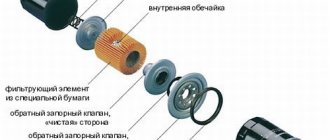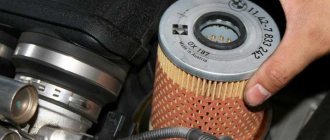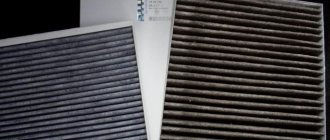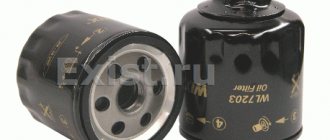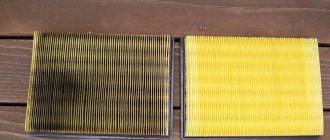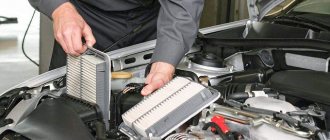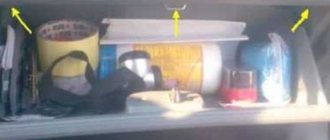A car owner usually encounters the problem of purchasing and replacing an oil filter during a vehicle technical inspection or during a scheduled oil change. The most experienced car enthusiasts know what the service life of filters of various brands is, as well as what indirect signs they need to pay attention to shortly before the filter resource is exhausted. In this material we will understand the design of this consumable, and also answer a number of questions: which oil filter is better, how to check the oil filter, etc.
A little about the device and functions
Like almost all elements of the lubrication system, filters are quite simple and reliable. Their service life under ideal conditions is 20 thousand kilometers, although in practice this mileage can be as little as 5 thousand kilometers. About a hundred years ago, cars did not require the use of special oil filters at all, but with their introduction, the service life of engines increased approximately threefold, and the volume of mandatory oil addition was reduced by ten or more times. At the same time, in practice, the following was determined: with each oil change, the filter must also be changed.
What does an oil filter do? Without understanding its structure and the operating principle of the system that includes such a filter, it will be difficult to understand. Take a look at the image above and let's use it to understand. So:
- When the engine starts and the pump starts operating, oil under sufficiently high pressure passes into the filter through special holes;
- The check valve, due to its elasticity, bends, allowing the oil to pass and enter the cavity between the filter housing and the so-called filter element;
- As the oil continues to flow through the filter element, it retains various particles with diameters from 25 to 45 microns, while the oil itself continues its movement to the engine through the outlet;
- If the oil is too thick (has not yet had time to warm up and change its viscosity), a special bypass valve opens. It is through this that thick oil can reach the engine without cleaning.
Obviously, by turning off the engine, the driver reduces the pressure in the oil system. In this case, the check valve closes and not only stops the flow of oil to the engine, but also prevents its outflow from the rubbing parts - thanks to this, you can not be afraid of a situation where, immediately after starting the internal combustion engine, dry friction will be observed in some of its parts. If the oil is too thick and cannot pass through the filter element in large volumes, it bends around it, passing through the opened bypass valve.
Important note : not all oil filters are equipped with the above bypass valve. In high-end cars, such valves can be located directly in the pump, lubrication system or oil line. Accordingly, filters for such vehicles should not have a bypass valve.
To summarize : the filter traps solid particles that accelerate the wear of rubbing engine parts, and also helps fight dry friction - with a filter, you can start the car and get out on the road almost immediately.
Many car enthusiasts ask the following question: is it possible to wash the oil filter? In fact, the filter housing with gasket, cover and all valves can last a long time, but the filter element made of special paper needs to be updated. The fact is that small and large particles settled in the pores of the filter element are almost impossible to remove. If you try to do this, you are more likely to damage the element itself, causing it to leak oil rather than filter it. Most modern oil filters do not provide for individual replacement of the filter element, so you will have to buy the entire consumable assembly.
The principle of rating construction
When choosing the best oil filter, you can only talk about a specific car. Our test object was one of the best-selling cars in Russia - Kia Rio 3 with a 1.6 liter engine. As a “reference point” we took the standard Kia oil filter number 26300-35503, which is also used on many other Korean cars. Its mounting dimensions are almost standard by modern standards: thread M20x1.5, body diameter - 78 mm (outer diameter of the sealing ring - 63 mm). Having selected the most popular oil filters from well-known brands, we divided them into two categories - undoubtedly recommended or optimal for replacement if there are no other options for purchase.
Unfortunately, only imported parts will take part in the test: although a number of Russian companies produce analogues (for example, Nevsky Filter), they are not widespread, and it is hardly worth recommending a product that is difficult to buy.
PlaceNameRatingPrice
| 1 | Mahle OC205 | 10 / 10 | 310 |
| 2 | Bosch 0451103316 | 9.9 / 10 | 250 |
| 3 | Mann W75/3 | 9.9 / 10 | 300 |
| 4 | Hyundai/Kia 26300-35503 | 9.8 / 10 | 340 |
| 5 | Fram PH6811 | 9.5 / 10 | 230 |
Mahle OC205
310
The Mahle brand offers a huge selection of components for engines, from cylinder-piston units to consumables for maintenance. Mahle is one of the main suppliers of automotive production, and in this case there is no point in repeating the high quality of products once again.
The oil filter we are considering rightfully takes first place in the ranking of the best: a high-quality, thick-walled housing not only withstands pressure in the oil system during a cold start without deformation, but also unscrews conveniently: when using disc pullers, the edges on thin-walled filters often roll off, and you have to use “ the old-fashioned method with chain pullers and other, even less convenient methods. The bypass valve is calibrated for a pressure difference of 1 bar - with synthetic oil of the recommended viscosity for the Kia Rio, it will be securely closed, protecting the engine from the penetration of unclean oil. Fans of cheap semi-synthetic oils should be careful in winter - trying to drive with a cold engine will not be the best choice.
Main advantages:
- Prevalence.
- Exact fit of the seat to the car.
- High quality workmanship.
Minuses:
- Not detected.
10 / 10 Rating Reviews I can trust this brand - I have been using Mahle filters for more than one year and on more than one car.
Bosch 0451103316
250
The second indisputably recommended oil filter also has German roots, although the production of Bosch products has long been distributed throughout the world - for example, our “experimental” one comes from South Africa. In terms of area, it can be considered the leader in the test: a solid cartridge made of evenly laid corrugated paper occupies almost the entire 80 mm body. This did not affect the performance of the bypass valve - it is recessed inside the filter element, has a decent area and opens exactly at 1 bar of pressure difference.
The only thing I can find fault with is the anti-drainage valve - it works noticeably hard, although the manufacturer indicates an opening pressure of 0.12 bar, but it still has more resistance than Mahle. For a healthy engine this will not be a problem, but since the softer valve on the Mahle also effectively prevents the outflow of oil from the filter, this coarsening will still not benefit the overall rating score. The oil filter for the Kia Rio, manufactured by Bosch, takes a solid second place in the Price Expert's list of recommendations.
Main advantages:
- High quality filtration, long resource.
- Exact compliance with the manufacturer's requirements.
Minuses:
- Less balanced design than Mahle.
9.9 / 10Rating Reviews As the Germans themselves say: “Bosch ist Bosch.” This brand is trustworthy, and I have never been disappointed in the filters.
Mann W75/3
300
The MANN company is no less well-known supplier of consumables for automobile plant conveyors than Mahle. However, in our case, they failed to surpass their colleagues: this oil filter has a smaller height and, accordingly, filter element area than the Mahle OC205, therefore, it will be the best choice only for relatively little worn engines, into which synthetic oil with low and stable viscosity. In this case, faster clogging during the run between oil changes will not play a significant role, but the reduced height will make installation easier in a tight engine compartment.
The bypass valve here has a higher opening pressure of 1.3 bar. This is another argument in favor of our opinion: when working with viscous oil and heavy clogging, before the valve opens, the filter element curtain may already be damaged.
The advantages of the filter include the deep notch on the bottom, which is convenient for unscrewing with a disc puller - here, removing the filter will be easier compared to Mahle or Bosch. But, alas, ease of car maintenance comes in second place after the quality of the filter itself - hence the decrease in score.
Main advantages:
- Ease of installation.
- Overall high quality workmanship.
Minuses:
- In comparison with both standard and analogues, the area of the filter element is reduced.
9.9 / 10Rating Reviews According to tests by automotive publications, this oil filter is one of the best. I will add to this the convenience of replacement.
Hyundai/Kia 26300-35503
340
In the last test (spark plugs for Renault Logan), the original spare part became the undisputed leader in the rating. Alas, the Kia Rio was less fortunate with the original filter - its price is a third higher than that of high-quality analogues, while both in terms of filtration quality and the area of the filter element, the Asian filter lost to its German counterparts.
The price looks especially strange: almost all popular original spare parts from Korean companies are cheaper than their analogues, which at one time became one of the main measures for promoting them on the Russian market. Here Kia failed to distinguish itself.
The verdict is simple - purchasing this oil filter is optimal for a new car if you are a convinced supporter of using only original spare parts.
Main advantages:
- Exact match to the engine design for fit and calibration of the bypass valve.
Minuses:
- Not the best price to performance ratio.
9.8 / 10 Rating Reviews I don’t want to experiment with what is better or worse: I choose only original spare parts. But he’s calm.
Fram PH6811
230
The French-made filter deserved attention not only due to its externally high quality of workmanship, but also due to its height: a very solid filter element had to fit into the 80 mm housing, which gives reason to count on high-quality filtration with low resistance.
Alas, in fact, the large height is associated with the design of the bypass valve - its substantial dimensions did not allow the filter element itself to distinguish itself. Of course, a large valve is not a disadvantage: on the contrary, the larger its area, the more accurately it can be adjusted. But if we consider that the main characteristics of the filter are comparable to MANN, and their price is practically the same, our choice between these two filters will be obvious.
We recommend: What is the fuel consumption of the VAZ 2114 per 100 km
The sealing ring here is narrower than that of Mahle or MANN - on the one hand, it will stick less to the mating plane during operation, and the filter will be easier to change, on the other hand, it will be easier to damage it if the tightening force is excessive. So you should tighten the Fram filter according to the instructions, and not “with a reserve”.
Main advantages:
- Overall high quality workmanship.
Minuses:
- The filter element could have been larger.
- The body (cut) is not the most convenient for pullers.
What types of oil filters are there?
The design of the most common oil system consumables was described above, but upon closer examination you can understand how oil filters differ for different types of vehicles. According to the cleaning method, oil system filters are divided into the following:
- Mechanical;
- Centrifugal;
- Gravity, also called settling tanks;
- Magnetic.
In addition, filters are also divided into completely non-separable and collapsible with a replaceable filter element. Additionally, oil filters are divided into three more large subcategories:
- Partial flow – filtering parts of the lubricating fluid;
- Full-flow – transmitting and filtering all passing lubricant;
- Combined – combining features of filters from the two above subcategories. They are usually found in cars with diesel engines.
The most common are mechanical filters, the heart of which is porous materials. The most common are cylindrical filter elements made of paper folded like an accordion. These are the filters that are installed in most passenger cars. Large equipment and trucks are additionally equipped with a coarse filter , which retains large fractions (from 60 to 70 microns). And only certain types of transport have a settling filter that collects the largest fractions.
The magnetic filters mentioned above are fundamentally different from all others. They are built into the oil pan. They are needed to collect metal contaminants, such as steel shavings and small particles of ferromagnetic materials that have gotten into the oil. Magnetic filters are very miniature and resemble a cork in appearance.
How to determine the need to replace the oil filter
According to experts, the entire consumable or mechanical filter element should be changed every 10 thousand kilometers and you should never think about whether the oil filter can be used twice - even after careful filtering, the filter “accordion” will remain too dirty.
indirect signs indicating the need to replace the filter :
- Serious deterioration in engine performance;
- The appearance of black exhaust when applying gas;
- Deviations of oil pressure readings from normal values;
- Appearance of a light signal on the control panel.
It is not entirely correct to believe that the filter should be replaced only when the filter element is heavily clogged with small or large fractions. It is not uncommon for the check valve to fail. The presence of such a problem can be judged by the duration of the light signal from the emergency oil pressure lamp.
Also, do not forget that problems with the oil system can occur immediately after replacing a faulty filter. In the vast majority of cases, their cause lies in a malfunction of the oil pump, and very rarely - when an air lock appears.
How to choose a good oil filter?
When choosing a filter for automobile oil, experts recommend paying attention not only to the manufacturer, but also to other important criteria:
- Appearance of the case. It must be intact, without small cracks, breakages or other damage. Otherwise, it will quickly become unusable at constant high voltage.
- A quality certificate that comes with parts from well-known manufacturers.
- Availability of high quality seal.
- Thick and durable filter paper. If the cardboard from which the filter element is made is of poor quality, it will quickly tear, and debris and other impurities will enter the engine.
Don’t forget to pay attention to the car manufacturer’s recommendations and the characteristics of your own car (make, mileage, engine size). There are 3 main types of oil filters - full flow, partial flow and combined filtration.
- Partial flow. It differs in that only a certain amount of lubricant passes through the filter. Cleaning takes place in a separate compartment where a valve separates the purified oil from the rest of the viscous liquid. This type of filter is considered one of the most reliable and high-quality.
- Full threaded. Passes lubricant through itself in full. When the oil pressure in the filter reaches its limit, an additional bypass valve opens.
- Combined. Combines the two above types of work.
Filter type
There are three types:
- Full-flow - it contains a bypass valve that regulates the oil pressure in the lubrication system. Its purpose is to protect seals and interblock gaskets from damage and rupture, as well as to ensure the bypass of excess pressure from the crankcase to the engine part. In the event of a filter becoming clogged or its service life finally exhausted, the valve is responsible for the flow of unrefined oil in order to avoid oil starvation and prevent overheating of the engine unit.
- Partial-flow - in comparison with the first ones, they produce finer filtration, which will require a longer process and more time. On the other hand, this operating principle will allow you to avoid pressure drops if the filter becomes clogged or the bypass valve gets stuck.
- Combined - perform extra-fine cleaning of oil fluid, combining the advantages of the two previous types, excluding the inherent characteristic disadvantages. The cost will be significantly higher, but with the greatest probability and increase in the work of adjacent pairs. Most often used in units with heavy loads.
We recommend: The VAZ-2114 stove does not heat well - causes and solutions to problems
Bypass valve serviceability
When purchasing a filter, this aspect is difficult to check, but if possible, you need to check the openness of the pressure valve. In this way, it will be possible to protect the engine from the penetration of unrefined oil containing a large amount of abrasives. Using an analogy, you can organize a check of the reverse shut-off valve for tight closure, excluding oil leakage, in the event of a long period of inactivity of the car.
Paper density
The parameter is a dependent link that affects the operating capabilities of the filter. The thickness of the paper affects the susceptibility to clogging and complete depletion. Some details should be taken into account regarding the maximum degree of heating of the oil in the engine. It is necessary to determine the permissible temperature during operation in order to prevent paper burnout during normal engine operation.
Hull integrity
An important secondary indicator that directly affects the performance of the filter. Before buying a spare part, you need to check the body and valves for malfunctions and defects, as well as the integrity of the filter paper. A branded product produced by a branded manufacturer stands out for its durability. A fake quickly fails and entails a chain of serious breakdowns. To avoid trouble, you should look at well-known manufacturing companies that provide appropriate certified documents for products that meet user requirements.
Choosing the right oil filter
The most common oil filters can be very similar to each other. Considering that today many manufacturing and packaging companies offer consumables from different price categories, making the right choice is not so easy. A competent car enthusiast should know that when selecting filters, you should pay attention to the following parameters:
- Construction type;
- Cleaning method;
- Thread type (metric or inch);
- Bandwidth;
- Degree/quality of purification (nominal and absolute parameters are key);
- Bypass valve opening pressure.
The easiest way is to select a new filter using the code of the old consumable. To do this, you need to dismantle it and study the inscriptions on the case. If a car enthusiast cannot do this yet, then you can search for a spare part using the car’s parameters. These include:
- Make and model of the car;
- Engine parameters (including model, year of manufacture).
In certain cases, searching by VIN code is faster and more reliable, although in modern online stores the selection of the desired filter can be carried out using the so-called. the so-called full-text search, during which the buyer will fill in the “gaps” in information about the car with data from drop-down menus - this is also very fast, but does not exclude the human factor.
How to check the oil filter
Unfortunately, it is impossible to check the quality of the oil filter without installing or disassembling it and inspecting the contents. The only sure way not to make a mistake in terms of selection is to trust a good manufacturer and choose a trusted seller who is responsible for the product being sold.
Original oil filters are a win-win option. But they are much more expensive than their analogues. Therefore, motorists are increasingly trusting third-party manufacturers who sell high-quality products.
Filter manufacturers and packers
Today, many companies offer automotive consumables. Some are manufacturers who often distribute their products under brand names of the same name, while others are packagers who sell the former's products. It is still worth focusing on manufacturers, and giving preference to those who are suppliers to the conveyor belts of automobile concerns. Here it is worth highlighting the following brands:
- High quality at a high price: Purolator, MANN, GoodWill, Champion, Mahle/Knecht, CHAMP, Union, FIAAM;
- Good quality and affordable price: Bosch, Sakura, Fram, Shaanxi, SCT, Finwhale.
If you come across a mechanical oil filter from a little-known manufacturer, then pay attention to the following things:
- The spring must be steel. It is the most durable and guarantees normal operation of the filter;
- The filter element must be laid flat, without visible gaps. Pay attention to the quality of the material - if it is suspicious, it is better not to buy a filter;
- The sealing gasket should be quite rigid. In addition, it must have the correct shape. If a given filter element “floats”, the filter element itself will move;
- The central filter tube must have the correct shape. Perforation must be performed to a high level. The entire design is designed to be strong and reliable - this prevents the filter element from collapsing.
As a standard, you can take filters from MANN or Mahle/Knecht, although Japanese Sakura filters are also suitable - they are very inexpensive, and in terms of workmanship they are practically not inferior to their expensive European counterparts. It’s difficult to say anything about the products of packaging companies As a rule, these companies cannot maintain a high quality standard. Spare parts from one supply may be of very high quality, but not from another.
Installing a new filter
So, the car enthusiast was able to select and purchase the desired filter. The question remains: how to remove the oil filter and then install a new one? There are no particular difficulties here, although the specifics of the work largely depend on the make and model of the car. We will try to give general recommendations.
To carry out the work, the car enthusiast will need the following: a strap or multi-faceted wrench (the first is preferable), a screwdriver, lubricant (motor oil is suitable), gloves. Wearing gloves, you need to unscrew the old filter. Sometimes this is difficult to do - the filter could have become stuck or it could have been tightly screwed in with a special tool. A screwdriver can help, with which several holes are made in the filter, after which it is easier to unscrew it by hand.
The old filter is dismantled - time to start a new one. Apply a little motor oil or other lubricant to the rubber gasket of the oil filter. Next, you need to screw it in by hand and then tighten it with a wrench. Now all that remains is to add new oil to the engine, let it run for a few minutes and check if there is any oil leakage through the new filter. Check point: checking the oil level and adding it if necessary.
FAQ
We will answer a few more very popular questions that both experienced car enthusiasts and novice drivers may ask. So:
- Where is the oil filter located? Answer: you should look for it closer to the crankcase protection, that is, in the lower part of the internal combustion engine. Often, working with a heavily tightened and stuck filter is only possible from under the car - the vehicle has to be driven into a pit, although you can get to the filter from above;
- Can an oil filter be used as an air filter? Answer: yes, in theory this is possible, but it is fraught with problems. Air filters trap particles of smaller diameter than oil filters. Many experts argue that the number one filter for modern cars is air filters, so there is no point in experimenting with replacing them;
- Why does the oil filter burst? Answer: the reason lies in large pressure differences between the “dirty” and “clean” sides of the filter. Filter rupture and inflation occurs due to a malfunction of either the filter bypass valve or the oil pump safety valve;
- Why is the filter dry? Answer: The problem lies in the oil filter check valve. This filter needs to be replaced as soon as possible. The malfunction can be identified even before unscrewing the filter - if the emergency oil pressure lamp lights up for more than 7 seconds after starting the internal combustion engine, the check valve does not cope with its task.
As you can see, due to the simplicity of the design of mechanical oil filters, diagnosing their malfunction is quite simple. However, we should not forget that the problem may lie in other components of the oil system - the pump, for example.
Conclusion
There are no particular difficulties in choosing oil filters. You can be guided by the characteristics of the car or the VIN code, not forgetting to also pay attention to the manufacturer. Answering the question of which oil filter is better is not so simple, but above we have listed several of the most well-known and trusted manufacturers. Their products can also be found in the so-called assortment. top-level packaging companies selling spare parts made in Europe, America and Japan.
Spare parts for daf 45
Piston rings for 1 cylinder, 2nd repair (+0.50)
FA 45.140 FR103S1
Replacement intervals
Each manufacturer sets its own service life for parts. Despite this, there are general recommendations for replacing the oil filter:
- When driving on mountain slopes, uneven roads and extreme driving styles, replacement is needed every 6-8 thousand kilometers.
- In all other cases, no more than once every 10 thousand kilometers.
The oil filter not only allows you to clean the liquid from impurities, but also performs a number of other, no less important, functions:
- Reduced motor noise during operation.
- Creation of an oil film that protects parts during friction.
- Protection of internal mechanisms from overheating.
